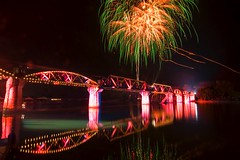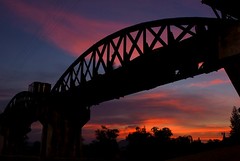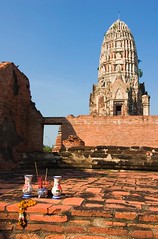The River Kwai Bridge Week, Kanchanaburi, Thailand opens with a bang as the sound and light show is brought to a finale with fireworks.
The Show uses coloured lights, sound effects, narration, actors, smoke, explosions, remote-controlled planes, fire and fireworks to retell the story of the Japanese invasion of South-East Asia, the building of the Thai-Burma Railway, the death of thousands of workers and Allied POWs and the bombing of the Bridge Over the River Kwai by the Allies during World War 2!
The photo was taken from the River Kwai Floating Restaurant. Thank you to Rose for giving me permission to photograph from the restaurant.
Wednesday, 3 December 2008
Sunday, 30 November 2008
Fizzy Offering
Offerings of food and drink in front of a spirit house in Thailand. Almost every building has a spirit house populated with small plastic models of people to represent the good spirits that are invited to dwell here and so ward off bad spirits.
Labels:
Photography,
Religion,
Spirit Houses,
Thailand,
travel
Wat Tham is Love?

Wat Tham Khao Noi?
This may sound like a question but it is, infact, the name of one of two twin hilltop temples just south of Kanchanaburi that we visited on Monday 24th November. We took a bus out of the central bus station to a junction near a dam then got on the back of two motorcycle taxis over the dam wall for the 6km ride to the base of the hill.
As we motored along, I sped while Georgia’s driver took it more slowly for her and the bump, I looked up for the hill and its temples. The only hills I could see where miles away and devoid of any roofs, prangs or chedis. I began to think we must be heading the wrong way, abducted by highwaymen motorcycle taxi drivers taking us deep into woodland to bag our wallets. The photos I had seen of the temples showed three pagodas crowning a steep wooded mountain top that clearly towered over the surrounding land. The guide books talked of a funicular railway to take pilgrims and tourists to the top.
The road took turns in alternate directions. The hills were not visibly getting any nearer so clearly they were more than 6km away. Then, after one final turn to the left the pagodas came into view, barely rising above the nearest banana plantation. What in my expectation had been a cloud-scraping mountain turned out to be a much less lofty hill, one that could easily be at home in Norfolk. We were delivered to the base of the protuberance right at the start of the not-much-larger-than-toy-sized funicular, a track of not more than 100 metres on which ran two silver ‘carriages’ with enough space to take maybe four or five families. We succumbed, shunning the short flight of steps next door for a 10 baht, 10 second shudder up the escarpment and on to the plateau.
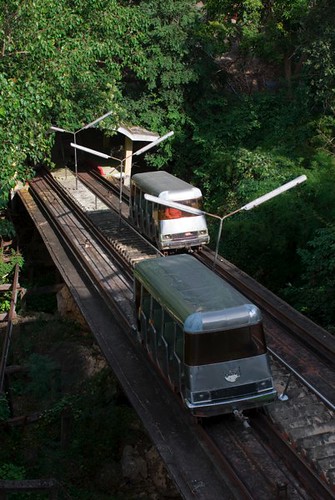
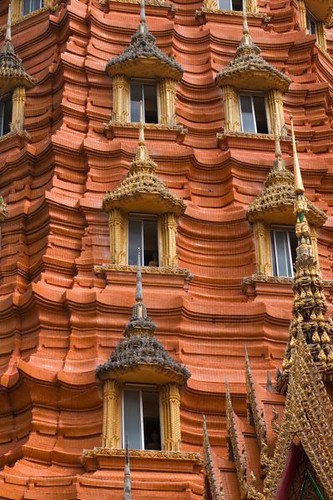
The two temples are one Thai Buddhist and one Chinese Buddhist. The Thai temple - Tham Khao Noi - has a giant, golden mosaic-covered Buddha that sits within a flame shaped canopy next to red-roofed temple halls and two orange pagodas tapering to golden points. No surface is left unpainted, ungilded or devoid of a twist or turn of some form of architectural embellishment. Each pagoda contains numerous Buddha statues in window niches on seven dark floors. The small windows allow in only narrow shafts or light that are hardly augmented by strip lighting. Sometimes two or three Buddhas are stuffed into a niche or a larger group are deposited seemingly randomly on a table. The views down onto the other temple buildings and across vivid green rice paddies to distant wooded hills are those of built and natural tranquillity.
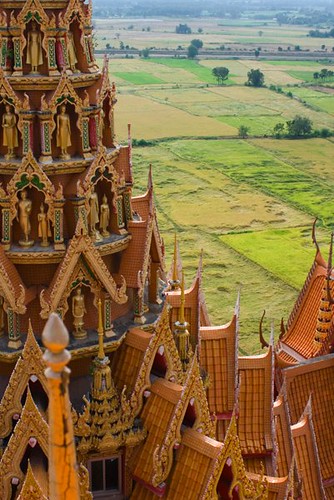
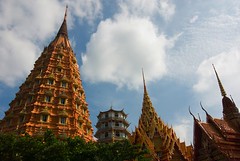
But all the time there is another presence looming. This is the Chinese pagoda of Wat Tham Suew next door. Totally different in style, the hexagonal, vertical-walled pagoda is seven floors of large, flat pastel colours, each floor under a sloping tiled roof so archetypical of Chinese style. Buddha statues could be glimpsed silhouetted in the doors. Inside, a single Buddha statue occupies the centre of each floor and the feeling is of natural light, open, uncluttered spaces that are freshened by gentle breezes. Outside the ornate clutter of the Thai pagodas make architecturally wrought attention-grabbing stratagems less anyone dwells too much within the Chinese pagoda.
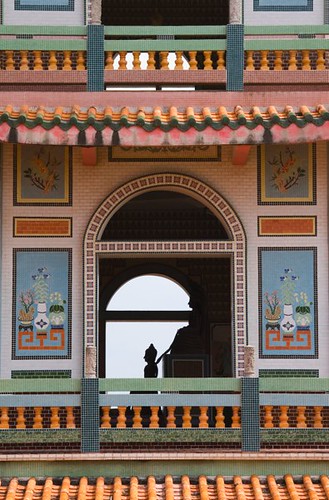
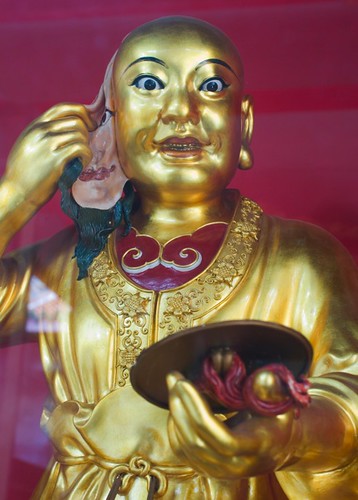
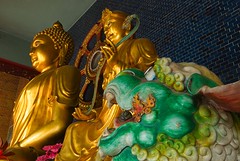
The way up to the Chinese pagoda is not gifted with a funicular, but instead is a series of Escher-like stairways and walkways threading through a number of temples complete with Chinese statues of characters that clearly evoke thought-provoking stories on ways of living. Inside the pagoda, the walls are decked with thousands of tiles, each with a small Buddha image. As we descended back to terra firma we heard chanting and a bell from one of these and saw a lone orange-robed monk praying before one of the Buddhas. The long decay of the bell and the sonorous chant held peace in the air.

As we motored along, I sped while Georgia’s driver took it more slowly for her and the bump, I looked up for the hill and its temples. The only hills I could see where miles away and devoid of any roofs, prangs or chedis. I began to think we must be heading the wrong way, abducted by highwaymen motorcycle taxi drivers taking us deep into woodland to bag our wallets. The photos I had seen of the temples showed three pagodas crowning a steep wooded mountain top that clearly towered over the surrounding land. The guide books talked of a funicular railway to take pilgrims and tourists to the top.
The road took turns in alternate directions. The hills were not visibly getting any nearer so clearly they were more than 6km away. Then, after one final turn to the left the pagodas came into view, barely rising above the nearest banana plantation. What in my expectation had been a cloud-scraping mountain turned out to be a much less lofty hill, one that could easily be at home in Norfolk. We were delivered to the base of the protuberance right at the start of the not-much-larger-than-toy-sized funicular, a track of not more than 100 metres on which ran two silver ‘carriages’ with enough space to take maybe four or five families. We succumbed, shunning the short flight of steps next door for a 10 baht, 10 second shudder up the escarpment and on to the plateau.


The two temples are one Thai Buddhist and one Chinese Buddhist. The Thai temple - Tham Khao Noi - has a giant, golden mosaic-covered Buddha that sits within a flame shaped canopy next to red-roofed temple halls and two orange pagodas tapering to golden points. No surface is left unpainted, ungilded or devoid of a twist or turn of some form of architectural embellishment. Each pagoda contains numerous Buddha statues in window niches on seven dark floors. The small windows allow in only narrow shafts or light that are hardly augmented by strip lighting. Sometimes two or three Buddhas are stuffed into a niche or a larger group are deposited seemingly randomly on a table. The views down onto the other temple buildings and across vivid green rice paddies to distant wooded hills are those of built and natural tranquillity.


But all the time there is another presence looming. This is the Chinese pagoda of Wat Tham Suew next door. Totally different in style, the hexagonal, vertical-walled pagoda is seven floors of large, flat pastel colours, each floor under a sloping tiled roof so archetypical of Chinese style. Buddha statues could be glimpsed silhouetted in the doors. Inside, a single Buddha statue occupies the centre of each floor and the feeling is of natural light, open, uncluttered spaces that are freshened by gentle breezes. Outside the ornate clutter of the Thai pagodas make architecturally wrought attention-grabbing stratagems less anyone dwells too much within the Chinese pagoda.



The way up to the Chinese pagoda is not gifted with a funicular, but instead is a series of Escher-like stairways and walkways threading through a number of temples complete with Chinese statues of characters that clearly evoke thought-provoking stories on ways of living. Inside the pagoda, the walls are decked with thousands of tiles, each with a small Buddha image. As we descended back to terra firma we heard chanting and a bell from one of these and saw a lone orange-robed monk praying before one of the Buddhas. The long decay of the bell and the sonorous chant held peace in the air.

Labels:
Kanchanaburi,
Photography,
Temples,
Thailand,
travel,
Wats
Thursday, 27 November 2008
Indiana Jones and the Temple of Poon
Descending through the bowels of the earth.
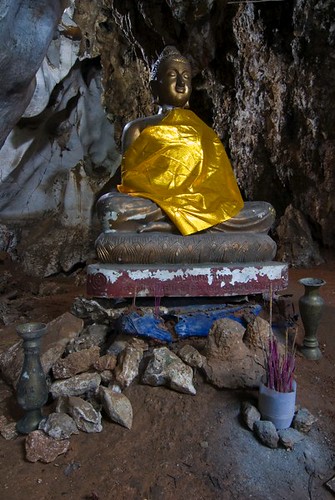
Buddha in a Cave
We visited one of the many caves in this limestone region of Kanchanaburi. The karst limestone forms teeth-like hills above ground, while below are found tunnels and chambers that prompts the idea that this is what it must be like to travel inside bowels and spines. Some of the caves are used as temples, others have more harrowing histories as Japanese World War 2 POW camps.
We visited Wat Khao Poon, a temple to Buddha and Ganesha and once a Japanese field hospital. After clambering down a flight of steep steps we came into a large, brightly-lit and roomy chamber with statues of the reclining Buddha and the rotund Chinese smiling Buddha. Beyond this is where the fun begins. Snaking and ducking along a series of narrow passages, brings us to one chamber after another. Each passage creeps further and further down into the ground, through broken and weathered limestone that looms into view as angular and bulbous formations akin to bones and bodily organs. Thankfully, very few of the walls ooze dampness.
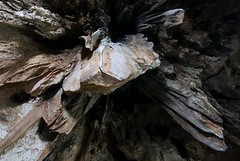
Mighty Ceiling Stalactites
Large fossilised waterfalls spring into each passage and chamber in the form of massive stalactites and stalagmites that cascade from roof to floor in absolute stillness. Some stalactites are ridged into furrows and fins, while others look like petrified ripples on a beach. Some form columns while others flow over the limestone corners and curves. In places, the stillness is broken by a gentle drip of water, showing that the processes of stalactite formation are still busy. Everything else is motionless - apart from us. The pale blue grey whiteness of the limestone is devoid of any colour energy; the warm fetid air is immobile while no sound echoes come back from footfall. But we keep descending; down, down, down between the rock.
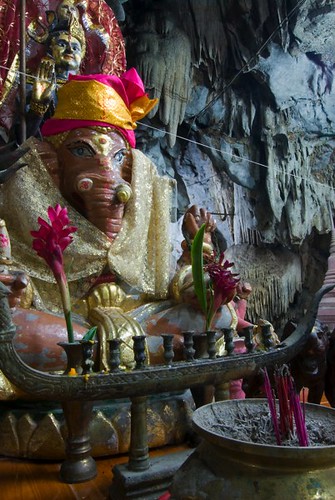
Ganesha
This lack of movement, in many ways, makes Wat Khao Poon a perfect place for meditation. Perhaps it is this, and a veneration of natural elements, that brought people to worship down here centuries ago. Each chamber is a temple or shrine. As we clamber through each opening we find statues of the Buddha, Brahma, Shiva and Ganesha set against the background of bent limestone and ribbed stalactites. Some images are dark, others golden, but most are draped in bright orange cloths. They are accompanied by dying flowers and burnt incense, while surfaces are covered in small squares of gold leaf. Each is a testament to an unseen act of worship.
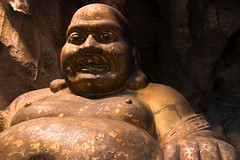
Laughing Buddha
Eventually we begin to climb, the turn in direction coming after the largest chamber with the largest Buddha statue. The air begins to turn a little fresher and at last the white fluorescence of the artificial lights give way to a warmer hue. We look up to see an opening, beyond which the green leaves and branches of a tree striate the blue sky. We return above ground, leaving the underworld once more in peace.

Buddha in a Cave
We visited one of the many caves in this limestone region of Kanchanaburi. The karst limestone forms teeth-like hills above ground, while below are found tunnels and chambers that prompts the idea that this is what it must be like to travel inside bowels and spines. Some of the caves are used as temples, others have more harrowing histories as Japanese World War 2 POW camps.
We visited Wat Khao Poon, a temple to Buddha and Ganesha and once a Japanese field hospital. After clambering down a flight of steep steps we came into a large, brightly-lit and roomy chamber with statues of the reclining Buddha and the rotund Chinese smiling Buddha. Beyond this is where the fun begins. Snaking and ducking along a series of narrow passages, brings us to one chamber after another. Each passage creeps further and further down into the ground, through broken and weathered limestone that looms into view as angular and bulbous formations akin to bones and bodily organs. Thankfully, very few of the walls ooze dampness.

Mighty Ceiling Stalactites
Large fossilised waterfalls spring into each passage and chamber in the form of massive stalactites and stalagmites that cascade from roof to floor in absolute stillness. Some stalactites are ridged into furrows and fins, while others look like petrified ripples on a beach. Some form columns while others flow over the limestone corners and curves. In places, the stillness is broken by a gentle drip of water, showing that the processes of stalactite formation are still busy. Everything else is motionless - apart from us. The pale blue grey whiteness of the limestone is devoid of any colour energy; the warm fetid air is immobile while no sound echoes come back from footfall. But we keep descending; down, down, down between the rock.

Ganesha
This lack of movement, in many ways, makes Wat Khao Poon a perfect place for meditation. Perhaps it is this, and a veneration of natural elements, that brought people to worship down here centuries ago. Each chamber is a temple or shrine. As we clamber through each opening we find statues of the Buddha, Brahma, Shiva and Ganesha set against the background of bent limestone and ribbed stalactites. Some images are dark, others golden, but most are draped in bright orange cloths. They are accompanied by dying flowers and burnt incense, while surfaces are covered in small squares of gold leaf. Each is a testament to an unseen act of worship.

Laughing Buddha
Eventually we begin to climb, the turn in direction coming after the largest chamber with the largest Buddha statue. The air begins to turn a little fresher and at last the white fluorescence of the artificial lights give way to a warmer hue. We look up to see an opening, beyond which the green leaves and branches of a tree striate the blue sky. We return above ground, leaving the underworld once more in peace.
Labels:
Cave,
Kanchanaburi,
Photography,
Temples,
Thailand,
travel
Tuesday, 25 November 2008
Bridge Over the River Kwai
We're currently staying in Karanchaburi, spending a few days at the Sugar Cane 2 Guest House right on the banks of the River Kwai. Yes that river, that bridge, that defiantly whisteld World War 2, that classic British film of British stiff-upper-lipness starring Alec Guinness.
The area is very beautiful which belies the terrible past it bore witness too as the Japanese forced thousands of POWs and tens of thousands of South Asian labourers to hand-build a railway line from Thailand to Burma - the infamous Death Railway. Visiting the huge POW cemeteries, of those died building the line through malaria-infested mountain jungle using picks, shovels, dynamite and wheelbarrows is very moving. Even more so, if knowing that many thousands more forced labourers from South East Asia were buried in unmarked graves, any fixed place for the memories of them being lost forever.
The area is very beautiful which belies the terrible past it bore witness too as the Japanese forced thousands of POWs and tens of thousands of South Asian labourers to hand-build a railway line from Thailand to Burma - the infamous Death Railway. Visiting the huge POW cemeteries, of those died building the line through malaria-infested mountain jungle using picks, shovels, dynamite and wheelbarrows is very moving. Even more so, if knowing that many thousands more forced labourers from South East Asia were buried in unmarked graves, any fixed place for the memories of them being lost forever.
Monday, 17 November 2008
Trat-a-rat-a-tat
We're now in a small eastern town called Trat, or Trrrrrrrrrrrrrrat, as you have to pronounce it before the Thais understand where you want to go. It is a maze of narrow alleys between wooden buildings buzzing with hundreds of mopeds. Walking around it is probably as close to getting an idea of what it must be like to be a slow, old hornet living in a hornet colony. The night market has probably one of the best places to eat we have found so far. All of Thailand is one big open-air restaurant with lots of vendors cooking up great stir-fries, soups and salads at each city or town's market. It is like having a vast open-air restaurant at each place with numerous kitchens and chefs to choose from. You can make up a three course meal in the same place from different cooks.
We're now on our way to an island for a couple of weeks holiday and snorkelling before our first antenatal check-up. We've already got advice on which clinics to go to, when, and translations of the questions we want to ask.
We're now on our way to an island for a couple of weeks holiday and snorkelling before our first antenatal check-up. We've already got advice on which clinics to go to, when, and translations of the questions we want to ask.
Offering to a Prang
As you wander around Ayutthaya you come across these offerings to Buddha in different ancient temples. Each is a little reminder that the faith that built these magnificent temples still holds them sacred.
Subscribe to:
Posts (Atom)
